Key takeaways:
- Personalization enhances attendee engagement by catering to individual interests and skill levels, fostering excitement and deeper connections.
- Interactive experiences, such as workshops and real-time feedback mechanisms, invite active participation and create a dynamic event atmosphere.
- Utilizing technology, like event apps and VR demonstrations, transforms experiences and facilitates networking, making events more immersive.
- Follow-up communication post-event is crucial for maintaining engagement and reinforcing connections made during the event.
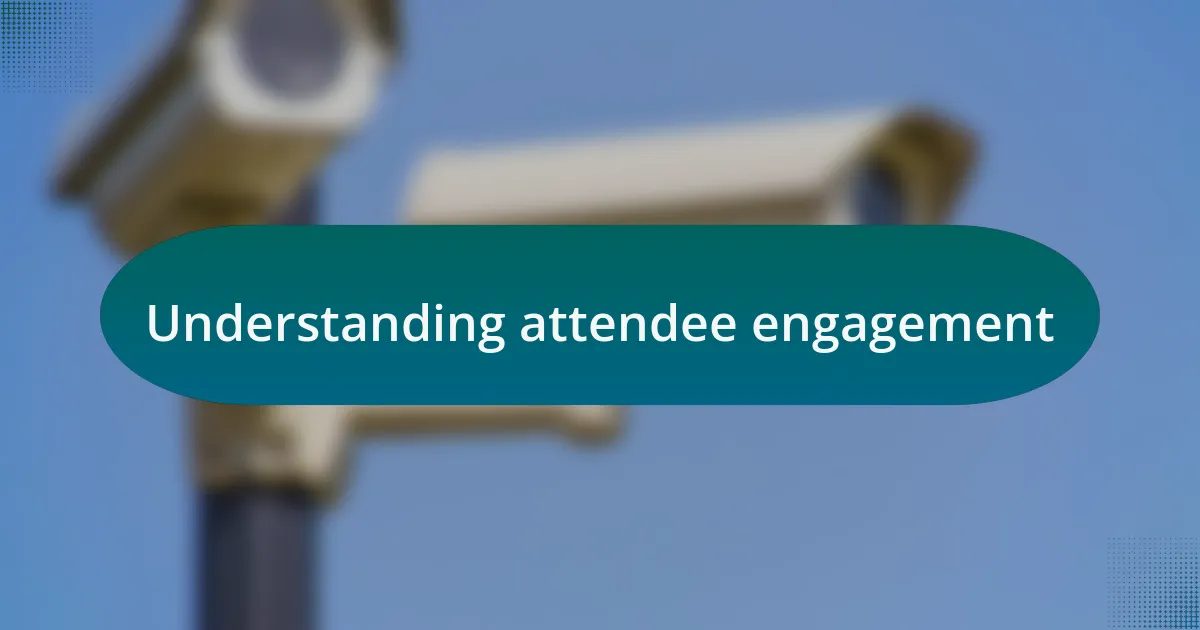
Understanding attendee engagement
Engaging attendees at tech industry events requires a deep understanding of their needs and interests. From my own experience, I’ve seen how crucial it is to create an environment where attendees feel not just welcome, but excited to participate. Have you ever been at an event that felt more like a chore than an opportunity? I have, and it’s a stark reminder of the importance of dynamic interactions and stimulating content.
One aspect that stands out is the power of personalization. I remember attending a conference where every session was tailored to various skill levels, which made me feel like the organizers really understood their audience. This attention to detail fostered an atmosphere of excitement and engagement. How often do we think about what our attendees actually want versus what we assume they need?
Moreover, feedback loops can transform the attendee experience. After a session, I’ve often found myself drawn to informal discussions where ideas and critiques flow freely. Encouraging this kind of open dialogue not only deepens understanding but also builds community among attendees. Isn’t it fascinating how a simple question can spark discussions that elevate the event experience?
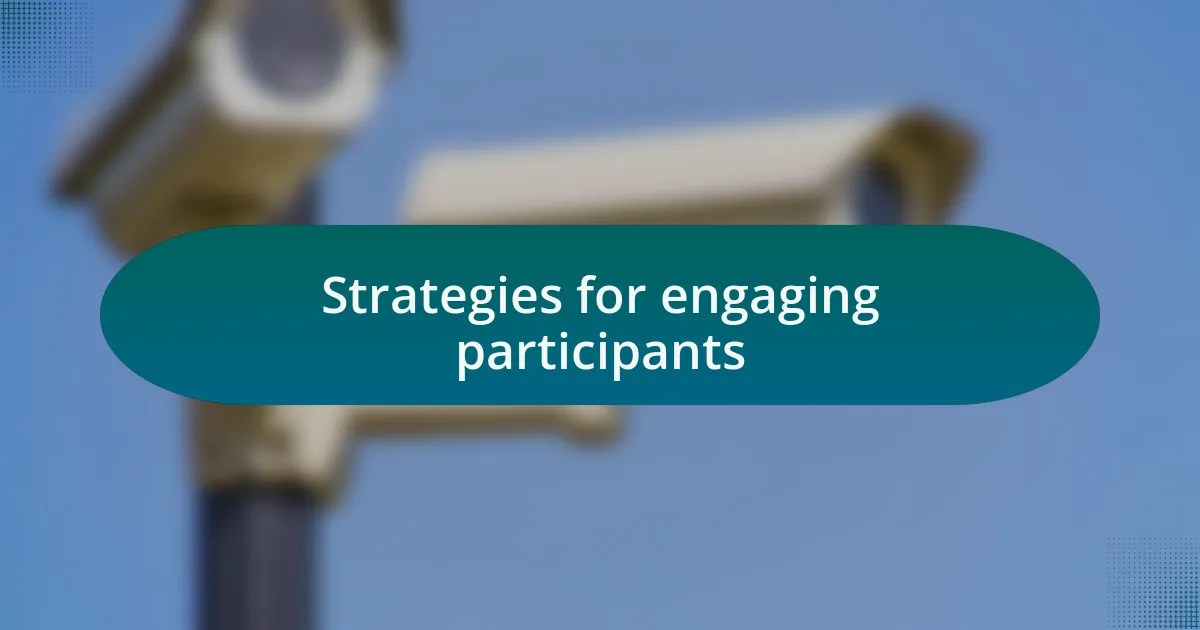
Strategies for engaging participants
Interactive sessions can significantly enhance participant engagement at tech events. In my experience, facilitating workshops instead of traditional lectures invites active participation. I recall a workshop where we were split into small teams to tackle real-life problems. The energy in the room was palpable, and I could see everyone thriving on collaboration. Have you noticed how much more invested participants are when they’re part of a solution rather than just being passive listeners?
In addition, leveraging technology can foster deeper connections. I once attended an event that utilized a dedicated app for attendees to connect, share insights, and ask questions in real time. This not only made networking effortless but also allowed for a dynamic flow of ideas throughout the event. Have you ever used an event app that truly enhanced your experience? I can honestly say that this particular feature transformed my approach to networking.
Lastly, don’t underestimate the impact of follow-up. After the event, I found that when organizers reached out to gather our thoughts and provided valuable content based on our interests, it kept the conversation going. It felt like I was still part of the event, even after it ended. How often do we think about maintaining that engagement once the final session wraps up? It’s crucial to remember that keeping the momentum alive is just as important as the event itself.
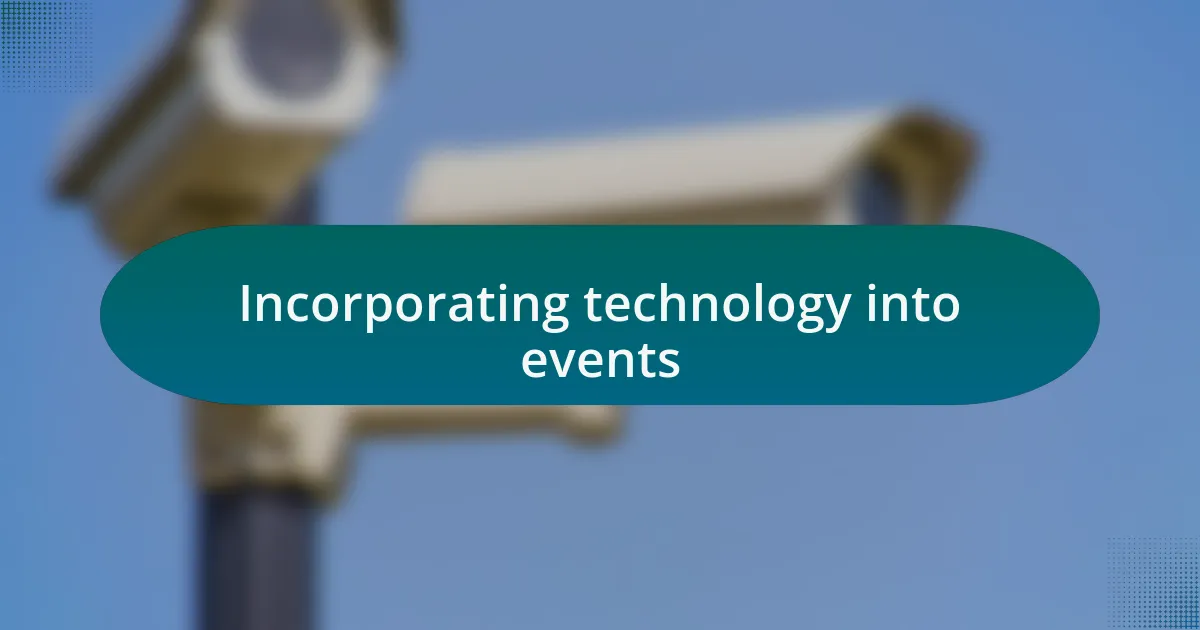
Incorporating technology into events
Incorporating technology into events doesn’t just streamline processes; it transforms experiences. I remember attending a conference where virtual reality (VR) stations were set up to simulate product demonstrations. The thrill of stepping into a VR world to engage with the technology broke barriers and sparked countless conversations amongst attendees. Have you ever felt so immersed in a tech demonstration that it changed your perspective entirely?
Another impactful use of technology that I’ve seen is live polling during keynote speeches. At one event, the speaker posed questions to the audience through a mobile app, instantly displaying theresponses on the big screen. It was fascinating to see real-time feedback, and I still recall the buzz of excitement as discussions sparked around varied opinions. Don’t you think that kind of interactivity elevates the entire atmosphere?
Moreover, utilizing social media walls at events can create a vibrant dialogue among participants. I once watched as a live feed showcased tweets and photos, allowing everyone to share their thoughts instantly. It turned the event into a shared experience, pulling people into conversations they might not have otherwise initiated. How powerful is it to feel included in a larger narrative while you’re physically present? This blend of in-person and digital engagement can really cement those connections.
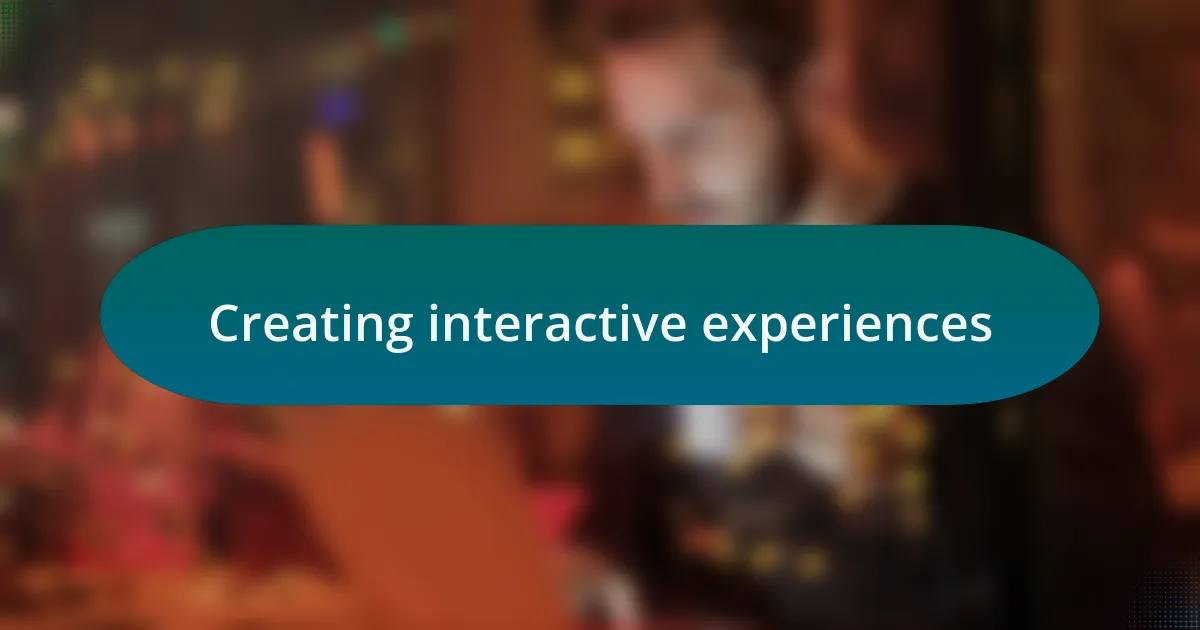
Creating interactive experiences
Creating interactive experiences is essential for fostering engagement at tech industry events. I once attended a workshop that featured live hackathons. Participants were divided into teams, tasked with solving real-world problems using technology within a limited timeframe. The adrenaline and camaraderie were palpable as attendees collaborated, and the thrill of competition sparked innovative ideas. Have you ever felt that rush of creativity when pushed to think on your feet?
Games can also enhance interaction in unexpected ways. At a recent tech fair, I encountered a scavenger hunt that guided attendees through different exhibitor booths. Each stop offered clues or small tech-related challenges. Participants were not just passively browsing; they were actively exploring, asking questions, and connecting with exhibitors. It transformed what could have been a mundane stroll into an exhilarating exploration. Isn’t it exciting when an event feels more like an adventure?
Additionally, integrating workshops where attendees can learn directly from industry experts cultivates a richer experience. I remember a session where participants were hands-on with the latest software, guided step by step. People were allowed to ask questions, making it feel more personal and less like a lecture. This environment not only enhanced the learning experience but also built a sense of community. Isn’t it refreshing to engage in discussions where everyone contributes and learns together?
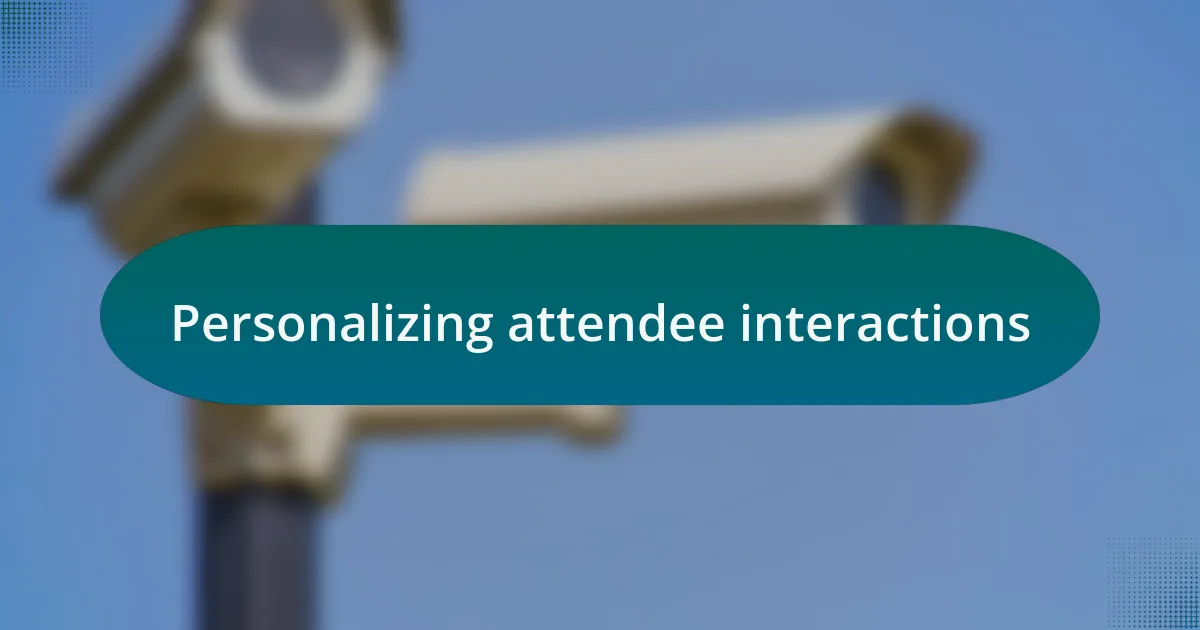
Personalizing attendee interactions
Personalizing attendee interactions is a game changer at tech events. For instance, during one conference, I noticed that vendors were not just showcasing their products but personalizing their pitches based on individual attendee interests. It was fascinating to watch how tailored conversations led to deeper connections. Have you ever experienced a moment when someone truly understood your specific needs? It makes all the difference.
In another instance, I attended a networking dinner where name tags had customized tags based on attendees’ expertise. This simple touch sparked conversations that were relevant and engaging right from the start. People were eager to discuss shared interests, and connections were formed quickly. Isn’t it incredible how a small detail can shift the entire dynamic of an interaction?
I often reflect on personalized follow-ups after events, too. One tech summit I joined had a system where attendees received tailored content based on their interests showcased during registration. This thoughtful approach made me feel valued and encouraged ongoing dialogue. Does it not feel nice to know that your preferences matter, even after the event has ended?
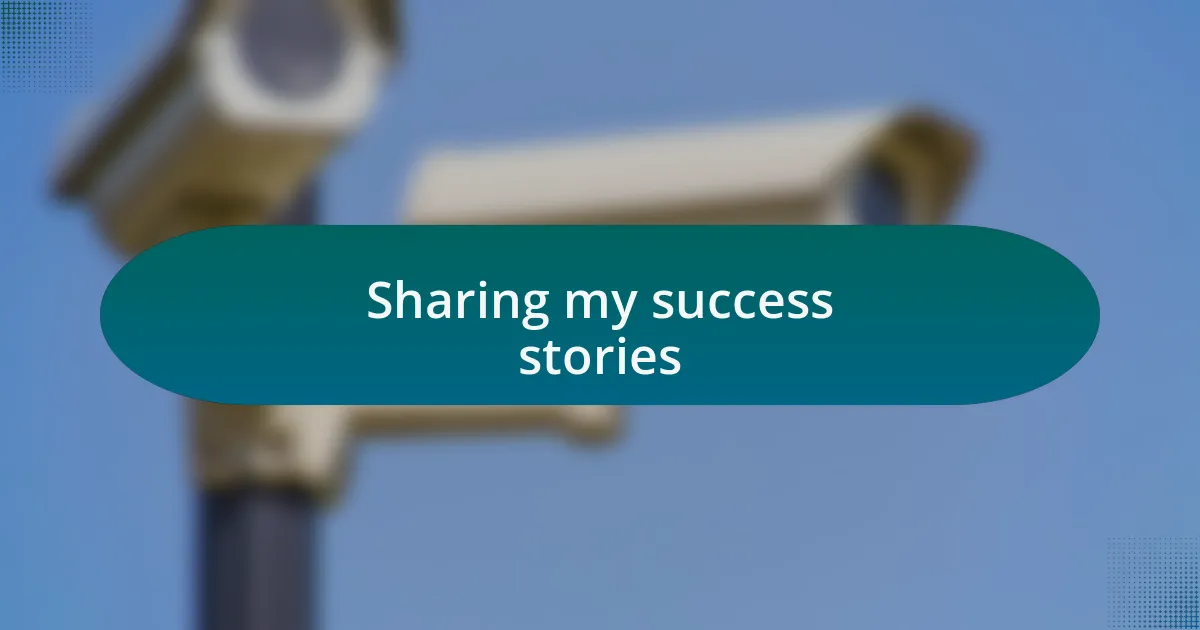
Sharing my success stories
Sharing my success stories often reminds me of a memorable workshop at a tech festival where I facilitated a small group discussion. I took the time to understand each participant’s background before the event and crafted an agenda that resonated with their experiences. The energy in that room was palpable; we ended up generating innovative ideas collaboratively. Have you ever witnessed a moment where shared knowledge sparked something transformative? It’s those connections that linger long after the event, creating a network of support.
In another instance, I remember organizing a breakout session focused on emerging technologies. Before the event, I surveyed attendees to gauge their specific interests, and I was thrilled to incorporate those insights into my presentation. The reception was overwhelming, as attendees shared their personal stories related to the topics discussed. Isn’t it inspiring to see how a shared enthusiasm can create a vibrant learning atmosphere? The bonds formed were not just professional; they often evolved into friendships.
One of my proudest moments was receiving feedback from attendees who felt a sense of belonging after an event I managed. I had implemented a platform where people could express their thoughts openly during sessions, making everyone feel heard. It’s incredible how that sense of community can transform an otherwise standard event into an unforgettable experience. Have you ever left an event feeling truly connected with others? These stories remind me that engaging experiences are rarely accidental; they require intentionality and a genuine connection.